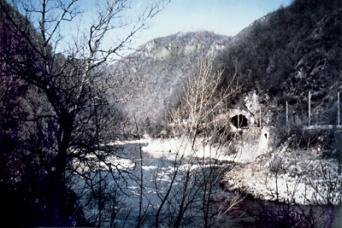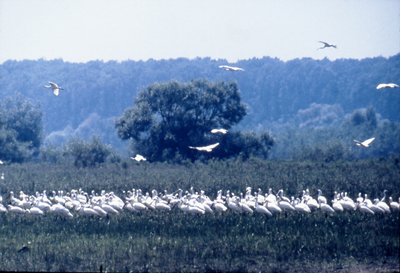Sava River, 1989
Atempause: Breathing Space for the Sava River (Atempause für den Save Fluss), 1989-1990
Click Here for the Exhibition Catalog
In 1989, while on a DAAD fellowship in Berlin, we were invited to Yugoslavia by Dr. Hartmut Ern, of the Berlin Botanical Gardens and asked if we could help with the formation of the nature reserve in the area that had once been a no-man’s land situated at the border between the former Austro-Hungarian and Ottoman Empires. This nature reserve existed as a many hundred sq. km. floodplain and the last of its type remaining in that part of Europe with endangered species and an ancient farming community who lived by an endangered wetland oak forest in oak pinframe homes, a miraculous place. We felt that such a reserve would find its uniqueness under attack from effluent of the surrounding industrial farming. Therefore, we proposed a nature corridor to protect it that would run the length of the Sava River from its twin beginnings above Ljubljana to its ending in Beograd at the Danube River, where it supplies the lower Danube with one third of its clean water.
INSTALLATION LJUBLJANA, THE SAVA BEGINS IN TWO PLACES
A COAL MINE OUTFALLS, BUT THE RIVER RECOVERS.
WHEN ONE SIDE IS HEAVILY USED, THE OTHER SIDE IS OPEN.
A New History for the Sava
GRAVEL IS MINED, BUT THE RIVER RECOVERS.
SMALL DAMS ARE MADE, BUT THE RIVER RECOVERS.
THE NATURE RESERVE IS ABOVE ZAGREB, BUT SURROUNDED BY FACTORY FARMS.
POLLUTANTS FROM THE FERTILIZER FACTORY MODIFIED BY UNTREATED SEWAGE FLOW THROUGH THE NATURE RESERVE
Yet we know from having been there that a new story
A new history is being written for this river
A paper mill is the new history
A coal mine and black water is the new history
An atomic energy plant and heated water is the new history
A fertilizer factory and acid water is the new history
Subtracting the floodplain
and farming to the edge is the new history
The river is asked to process new information
When it hits the alluvial floodplain
and the information is mechanical.
A new shape has been constructed for the river
By the construction of levees and dams
So that the river is permitted to rise and fall but not to spread
And the topology for a giant farming system created thereby.
For the river it is the shape of catastrophe.
The river is asked to process new information
when it hits the alluvial floodplain
and the information is chemical
and the information is toxic
and where the information is most toxic
by an unexpected congruence of circumstances
and an unexpected confluence of waters
there is an intersection with the nature reserve.
There is still time for a new history for the Sava
Which, while corseted within levees
Is not channeled in concrete.
There is still time for a new history for the Sava
For its alluvial wetlands
While shrunken
Are larger than any in Western Europe.
There is still time for a new history for the Sava
For its dams are modest and covered with growth.
There is still time for a new history for the Sava
For its flow is not swallowed or reversed.
and while polluted, is not poisoned.
The shape of catastrophe takes on the quality of opportunity
When the great “U” formed by the Sava within its earthen walls
Is understood as a new continuum
A corridor for wildlife
That in tandem with the corridor for human activity
Serpentines through the 500 kilometers of the new topology
Produced by the 7000 sq. kilometer factory farm
Then the shape of opportunity
emerging from the sum over his histories
becomes he new history for the Sava river floodplain
the second largest alluvial wetland remaining
on the continent of Europe.
(excerpts from The Sava River Poems by HH and NH)
A SQUARE KILOMETER OF ACIDIFIED WATER FROM THE FERTIZILER FACTORY .
THE SHAPE ON THE 18TH CENTURY MAP IS CLOSE TO THE PRESENT SHAPE OF THE NATURE RESERVE.
THE STORKS ON THE ROOF ARE A BIO-INDICATOR OF HEALTH
THE FIELDS ARE MOWED SLOWLY, OVER A NUMBER OF WEEKS AND THE STORK POPULATION IS FED THEREBY, AND OTHER SPECIES ARE ABLE TO MOVE SO A BIO-DIVERSE MEADOW SYSTEM STAYS INTACT.
THE FIELDS BEFORE FLOODING
THE SPOONVILLE POPULATION
OPEN RANGE POLY-CULTURAL HERDING
THE FIELDS WITH FLOOD RECEDING
The Nature Reserve
In the nature reserve we were introduced
to a young ornithologist
Who had been studying habitat in the Poljes.
And he said
the nature reserve was very important
As it was part of
the second largest floodplain left in Europe.
We discussed his work.
He said
there were many endangered species
and the process of farming was historic in nature
and ecological provident
He said
the housing was still oak pin frame
with no nails used.
He said
the wetland oak forest
had been maintained
and sustained
since medieval times
He said
every house had a pear tree
and every grandma made slivovitz
from the pears
And
animals grazed collectively
and flooding was not resisted
but simply part of the natural cycle.
He said
he was thinking about proposing
Reed bed purification systems
For the waters from the sewage plant
We said
we had been working with the concept
of reed bed purification systems
and agreed with their use
not only in the nature reserve
but along all the channels
and drainage ditches
We said
organic farming
at the perimeter of the reserve
would not only help reduce
the amount of toxic farm wastes
but might help local farmers
move into the organic food market.
He said
his biggest worry
was the effect that the fertilizer plant
would have on the nature reserve
and asked
us to think about what could be done.
We said
we thought since there appeared to be
a two square kilometer pond
with the acidity of battery acid
within the reserve
funds should be sought immediately
not only to develop new ways
to process the wastes
but to begin to reduce the size of the pond.
We met with officials from the factory
they said, they knew the problems
and were working towards solutions
but they needed financial assistance.
The Outcome
The outcome of the Sava work was complex and unexpected. The Croatian water department accepted the concept. Our assistant on the site, the now prominent ecologist Martin Schneider-Jacoby from Euronatur, stayed on the site and continued to evolve our concept for the Sava River. Thereafter, he gained a multinational approval for a thousand square km. nature corridor for the Drava River, which is the sister river to the Sava, thereby setting up the conditions for the purification of the Drava. The outcome here was that the Sava and the Drava Rivers collectively gave the lower Danube almost 50% of its clean waters. These clean waters have the salutary effect of flushing the polluted estuary of the Danube River as it flows into the Black Sea. Our work, in ways not immediately apparent, often generates other related work, in a phenomena we call “Conversational Drift.” Waters from the Sava to the Drava to the Danube estuary are a metaphor on the ground for what we mean by “Conversational Drift.” The local communities we worked with were the water department, local environmental activists and ecologists. Oddly, no artists in the community chose to involve themselves.
Although our work in the former Yugoslavia was completed, our presence there ended with a telephone call from the German embassy, when we were working at the academy in Prague, ready to leave to speak in a Bio-diversity conference in Dubrovnik, we were told not to come as the trains were under assault. The conversation had become violent.
History
A catalog with full color illustration exists in German and English, and some copies in Serbo-Croatian as well, with translations into Serbo-Croatian, French and Japanese. The text, with several accompanying black and white images, has been reprinted in the Journal of International Synergy. The work has been exhibited in Berlin at the Neuer Berliner Kunstverein; the Museum of Modern Art in Ljubljana (Slovenia); the Museum of the Revolution in Zagreb (Croatia); the Centre International D’Art Contemporain de Montreal; the Palmer Museum at Penn State University; in New York at Ronald Feldman Fine Arts; at Washington University at Saint Louis and it won second prize at the Nagoya Biennale in Japan in 1991. Additionally, the work travelled as the centerpiece of an exhibition, Fragile Ecologies, touring the United States for three years
Where: See history above
When: 1988-1990
Scientists: Dr. Hartmut Ern and
Dr. Martin Schneider-Jacoby
Commissioned by: The Neuer Berliner Kunstverein and the Moderna Galeria of Ljubljana. Supported by the Berliner Künstlerprogramm of the DAAD and the Water Department of Croatia in Zagreb.

















